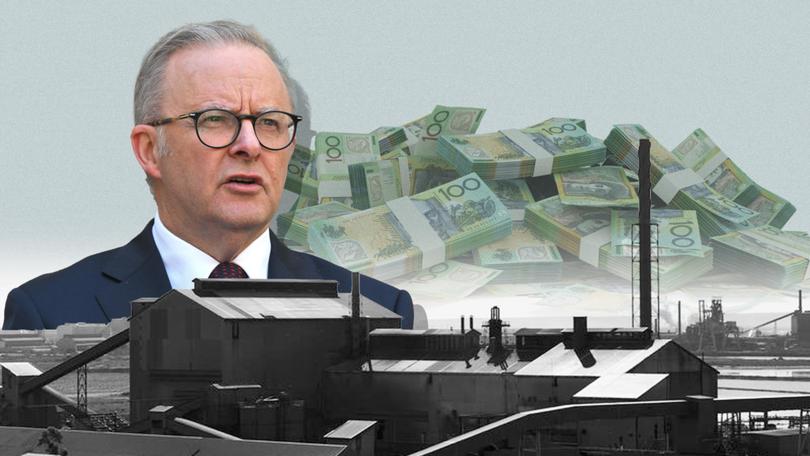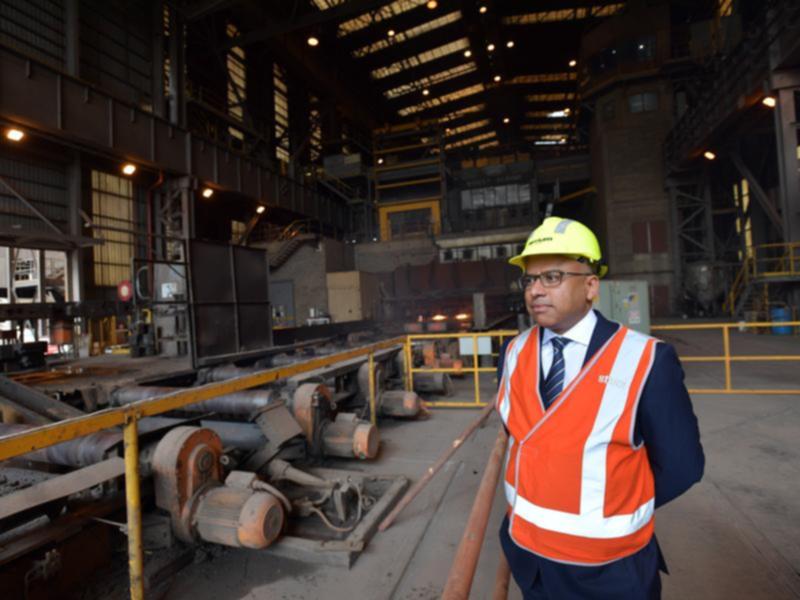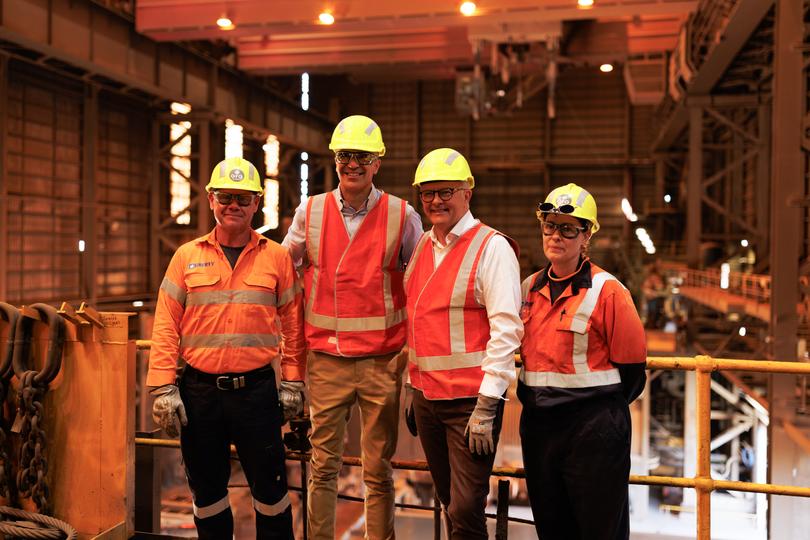Whyalla steelworks: Albanese Government lays out $2.4 billion lifeline to keep mill afloat

The Albanese Government has laid out a $2.4 billion lifeline to keep the Whyalla steelworks afloat, following the South Australian Government calling in creditors on billionaire Sanjeev Gupta’s GFG group.
In announcing the deal, which would see $100 million spent on immediate assistance and a further $384m stabilising the steelworks, Prime Minister Anthony Albanese said this was about creating certainty going forward, “to secure jobs, not just for the present, but importantly for this and future generations”.
Small creditors, with debts up to $1m have been offered a bailout by the South Australian Government that would see them paid in return for handing over the dividends received as part of the administration process.
Sign up to The Nightly's newsletters.
Get the first look at the digital newspaper, curated daily stories and breaking headlines delivered to your inbox.
By continuing you agree to our Terms and Privacy Policy.“This about relieving them (of) the burden and the struggle associated with administration so they can get on with doing what they do best, and that’s keeping this place running and making steel in this country,” South Australian Premier Peter Malinauskus said.
The steel mill employs 1100 workers and supports more than 2000 indirectly, with many smaller creditors based in the town of Whyalla and across the state.
However Mr Malinauskas said the government is not bailing out Sanjeev Gupta and the GFG Alliance.
“There is no bailout of GFG. They will have to deal with the process of administration,” he said.
A further $1.9b would be made available for the long term viability of the steel mill to assist a new owner to invest in upgrades and new infrastructure.
$500m of that would come from a newly created $1b Commonwealth Green Iron Investment Fund, while the South Australian Government’s share will be redirected from the State Office of Hydrogen Power which would be “wound back”.
“There’s no point in producing hydrogen if there is no customer,” Mr Malinauskus said.
“The first step is to actually realise what was supposed to happen from GFG, and that is getting the magnetite out of the ground, investing in the steel works, transitioning to electric arc furnace, and that needs to happen concurrently with the potential new owner of the steelworks.”
Whyalla accounts for 75 per cent of Australian structural steel and is the only domestic producer of long steel products. The Prime Minister said given its importance to the Australian market, the continuation of the steelworks was a national issue.
“The idea that Australia would be vulnerable for the shocks that can occur; a pandemic, international trade issues. We live in an uncertain world,” Mr Albanese said.
“Australia needs to be more resilient. It’s one of the lessons of the pandemic.”

The Australian steel industry is a significant contributor to the national economy, employing over 120,000 people and generating approximately $29 billion in annual revenue, according to the Australian Steel Institute.
Domestic crude steel production exceeds five million tonnes per year, with the construction sector the largest consumer.
Australia exports approximately one million tonnes of steel annually, generating approximately $1b in revenue, while steel imports average around 1.8 million tonnes per year.
Australian Industry Group chief executive Innes Willox welcomed the news, saying the country couldn’t afford to become overwhelmingly reliant on steel imports.
“While industry never likes the pseudo-nationalisation of an individual business, to have lost essential steel-making capacity in Australia because of a potential supply chain collapse would have been nothing short of a national economic security disaster,” Mr Willox said.
“Industry hopes this period of administration and effective government control will be short-lived and that either a new buyer or long-term management arrangements can be negotiated and found.”
Yesterday, the South Australian Government appointed KordaMentha as an administrator of OneSteel Manufacturing, the GFG-owned legal entity that owns and operates the Whyalla steelworks and associated mines for failing to pay debts to creditors and the government, including $15 million to SA Water.
Green dreams
Both Governments remain committed to the idea of “green steel” being produced at the Whyalla plant, a project that has long been an unfulfilled vision at the site.
When GFG group bought the site out following the collapse of BHP spinoff Arrium, Mr Gupta promised he would upgrade the plant for an era of environmentally friendly steel. The SA government committed to support the transformation with a $600 million to fund a 250 MW green hydrogen electrolyser and a 200 MW hydrogen power plant, both among the largest in the world.
That hydrogen plant, spruiked by Mr Malinauskus while in opposition, appears to have become a key sticking point in the breakdown in the relationship between the SA government and GFG. The Whyalla steel mill was to have been the main customer for the $600m plant, using electrolysers being built by General Electric in Ohio.
“If we produced a hydrogen facility without the steelworks being a customer of the hydrogen — because GFG doesn’t invest in the steelworks or, worse still, found itself in even more challenging financial circumstances than it is currently in — then we put ourselves in a precarious position,” Mr Malinauskus told ABC radio earlier this month.

At today’s press conference, Mr Malinauskus remained committed to the prospect of a hydrogen-powered steel industry.
“The future of hydrogen is there, and it’s clear, and people appreciate the necessity of it. I guess what we’ve got to make sure is that we’ve got a mine and steel-making business that is there in the first instance.”
Speaking on 2GB this afternoon, opposition leader Peter Dutton called the green steel project a “pipe dream”.
“A big part of the reason why, Whyalla has had problems is because of the cost of electricity. Why would you then turn around and say, ‘the way we’re going to get Whyalla back on track is to double the cost of their electricity through green hydrogen?’” he said.
“If the government’s continuing to put good money after bad with green hydrogen, then they will damage the economy and those local jobs will be lost.”
But the Chamber of Minerals and Energy WA welcomed the Government’s $1b green iron investment fund, saying it estimated that large scale production of green iron could generate $74b in economic value and nearly 20,000 jobs.
Chief executive Rebecca Tomkinson said that allocating a full $500m of the fund to Whyalla was an unfair allocation of the the money.
“Western Australia is best placed to become a significant manufacturer of green iron,” Ms Tomkinson said. “We have strong trading relationships with steel mills across Asia that are looking to decarbonise their operations. “It is vital (WA producers) are... prioritised for support through this new fund.”
Baethan Mullen, chief executive of the Superpower Institute, founded by Ross Garnaut, said the blame for the plant’s failure shouldn’t be placed at the feet of renewables. Despite the promises my Mr Gupta, much needed investment at the ageing plant never took place. That included replacing a cracked coal-powered blast furnace with a more efficient electric arc furnace.
“The state of the steel works is really the responsibility of the owner and the cause of the situation hasn’t been the energy availability,” Mr Mullen said.
“The choice is really at this point to reinvest in the existing blast furnace which is in very poor state of affairs, start to invest in the newer kinds of technologies that can be powered by renewables and green hydrogen.”
Adam Creighton, chief economist of the Institute for Public Affairs, a policy think tank said the failure of the GFG owned operation was a sign Australia should follow US President Donald Trump and scrap Net Zero targets that relied on renewable power.
“Green hydrogen is akin to throwing money into the ocean,” he said. “And now the Government is forced to invest in private industry as a result of its own stupidity.”

